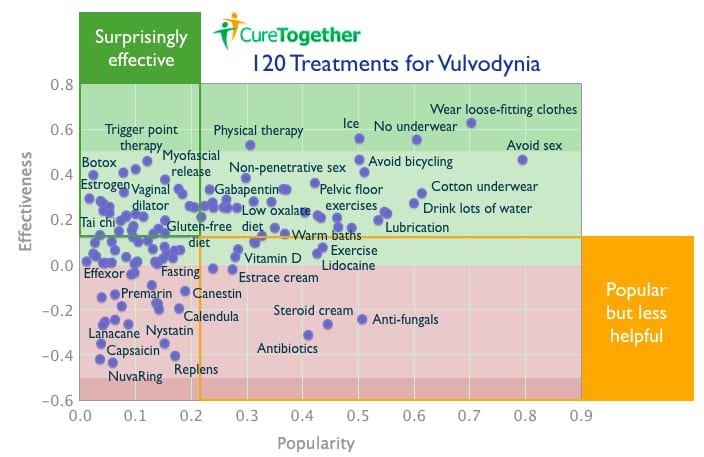 For the live-updated, fully-labelled, interactive version of this graphic, click here.
For the live-updated, fully-labelled, interactive version of this graphic, click here.
By Alexandra Carmichael, Co-Founder of CureTogether
Nearly two years ago, CureTogether released a list of the top patient-rated treatments for vulvodynia, a common form of female reproductive pain that makes regular activities like wearing jeans or having sex extremely painful.
A staggering 20 percent of women will experience vulvodynia at some point in their lives, so we at CureTogether decided it would be helpful to repeat the analysis and release an updated list of treatments rated by women living with the condition.
People in the study said they found that non-drug interventions like physical therapy, ice and wearing loose-fitting clothes were effective treatments. Conversely, those in the study said some treatments like NuvaRing, Replens, Capsaicin cream, and Lanacane actually made the condition worse.
These are all treatments suggested and reported by patients, so some redundancy in the terms used is to be expected. In addition, the term “treatment” in this study refers to anything patients describe using to help them feel better whether it is an officially prescribed medical treatment or not.
Most Effective Rated Treatments for Women with Vulvodynia
1. Wear loose-fitting clothes
2. Ice
3. No underwear
4. Physical therapy
5. Avoid sex
6. Rinse with water after urination
7. Trigger point therapy
8. Mysofascial release
9. Avoid bicycling
10. Osteopathic manipulation
Vulvodynia is a very common kind of female pain, but it is rarely talked about because many women are embarrassed by it. CureTogether is a free resource owned by 23andMe, and it allows people to share information about their health and treatments. In turn they can learn from others dealing with the same conditions.
CureTogether’s study compiled responses over four years from 1,969 people with vulvodynia, who rated the effectiveness of 120 different treatments. We’d like to thank those who participated. And just as they shared their experience with treatments, we’re freely and openly sharing the results of the vulvodynia study. We hope this will help raise awareness and let people feel like they’re not alone.
This is part of a regular series of CureTogether research findings. CureTogether’s research findings are different than those made by 23andMe, which look at genetic associations with illness, traits and drug response. But as we continue our work with the CureTogether community, 23andMe hopes to incorporate more of this kind of self-reported information into our own research. CureTogether present its findings just as they are – patient-reported data – to stimulate discussion and generate new insights for further research.
Please tweet, blog, or pass this along to anyone who can benefit or is interested in vulvodynia. Thank you!